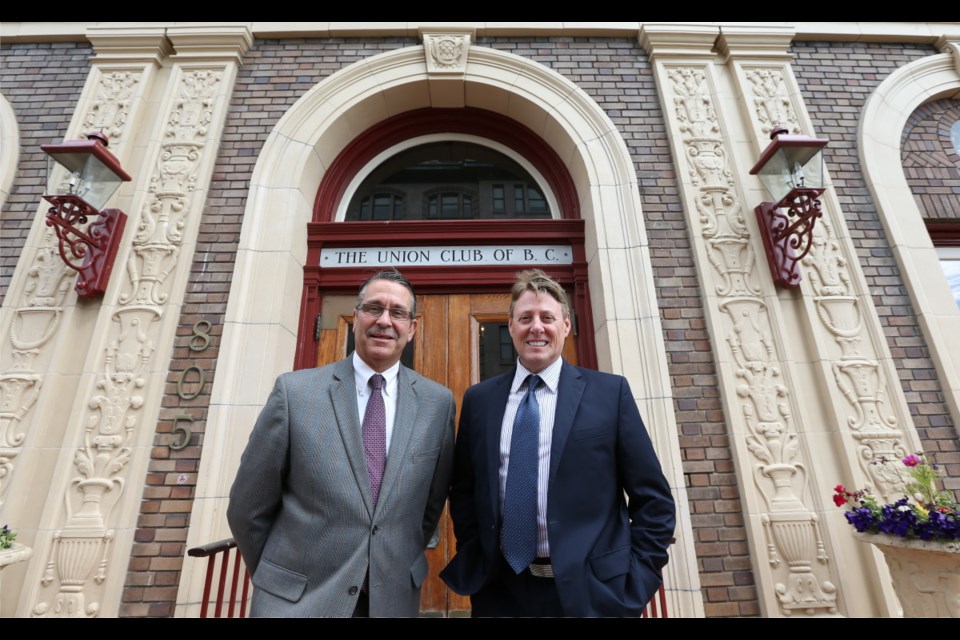The Union Club of British Columbia, founded in 1879 in a room over a butcher shop at Yates and Government streets, has gained national historic site status for its landmark Gordon Street building.
It was one of 13 designations for sites, events and individuals announced as part of Canada History Week, which runs July 1 to 7.
“We’re ecstatic,” said club president Bernard Beck.
“To have that designation is quite an honour.
“There’s been a tremendous amount of work behind the scenes in order to receive this designation. The application was made in 2010.”
About 30 such sites are in Greater Victoria, including the Empress Hotel and St. Ann’s Academy.
Previously, the Union Club received recognition in 1995 for national significance from Canada’s Historic Places, a federal, provincial and territorial registry.
The club’s first president was a judge, Sir Matthew Baillie Begbie, while the name “Union” was chosen because of a political will to keep Vancouver Island in B.C. and to maintain the province’s place in Canada.
“At that time there was a movement afoot to separate from British Columbia,” Beck said.
“So members of the Union Club formed an alliance to challenge this and to ensure the preservation of the Island as being part of British Columbia and being part of Canada.”
Members also worked on trade and commerce issues to so that Vancouver Island would become a commercial gateway, he said.
“The club contributed largely to shaping Greater Victoria, Vancouver Island and the province of British Columbia,” Beck said.
Membership grew steadily in the early years and when it reached 149 in 1884, the club decided to build its own building, buying property at Douglas and Courtney streets near St. Andrew’s Presbyterian Church. The clubhouse built there served until the early 1900s, when growing membership necessitated a move.
The result was construction of the club’s current Gordon Street location, former home to a badminton club, beginning in 1911. The first major event in the new surroundings was a ball held in 1913.
The club was built with a brick-and-terracotta exterior in the beaux-arts style, with architect Francis Rattenbury closely managing the project.
The building was designed by Loring P. Rixford of San Francisco, who was chosen after an international competition.
Total cost of the project, including furnishings, was $351,919.65.
“It’s a historical architectural landmark and we see it as essential to preserving Victoria’s prominent harbour gateway in the downtown core,” Beck said.
Following 115 years as an all-male organization, the club voted to allow women to join in 1994 with 87 per cent support. Lois Hobbs became the first female member.
Over the years, similar to today, the club has been made up of businesspeople, local politicians, government officials, academics and professionals. From the beginning, there has been an effort to be active in many aspects of the community, beginning with sports affiliations such as cricket and baseball.
“We are very much involved in the community through our outreach program,” Beck said. “We work with local charities like the Canadian Breast Cancer Foundation.”
The club is also a major supporter of the annual Symphony Splash and University of Victoria scholarships.
“We’re definitely part of the fabric in Victoria,” he said.
The club has 1,500 memberships, which include 2,300 to 2,400 members since spouses sign up together. They enjoy amenities such as fine dining, billiards, a rooftop terrace and a fitness centre.
Along with working in the community, the club continues to invest in its building, Beck said.
“We just underwent a major remediation and that cost us $2,758,000, just for the outside.”
Sites with a national historic designation have “profound importance” to the country, said a statement from Parks Canada, which oversees the selections.
“They express the rich tapestry of our country’s cultural heritage and their commemoration gives us an opportunity to connect these nationally significant aspects of our shared history to the hearts and minds of Canadians.”



